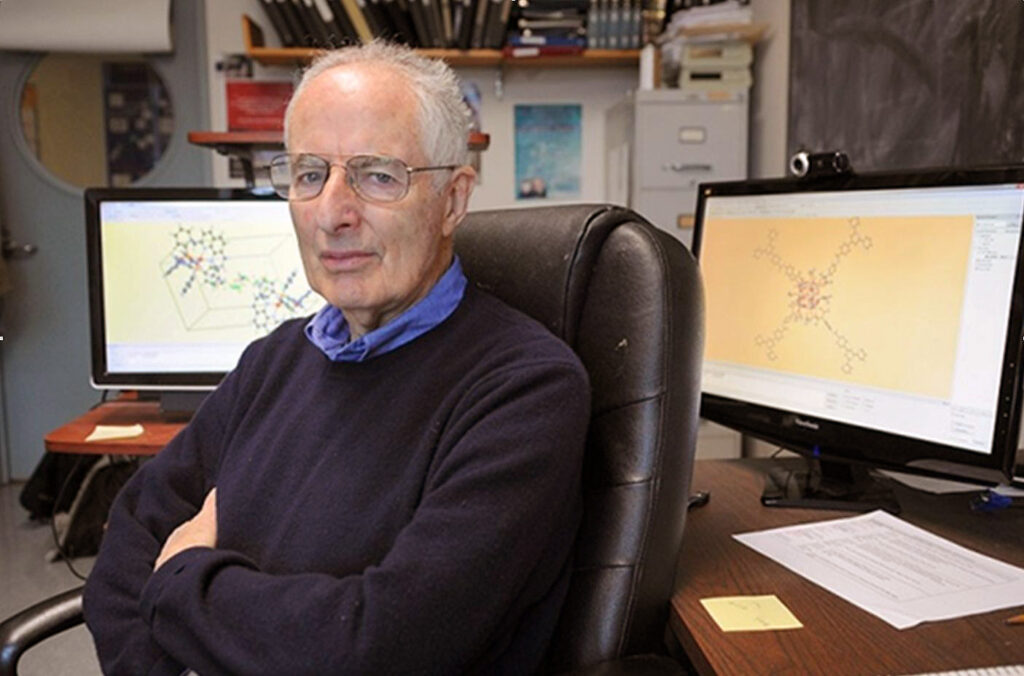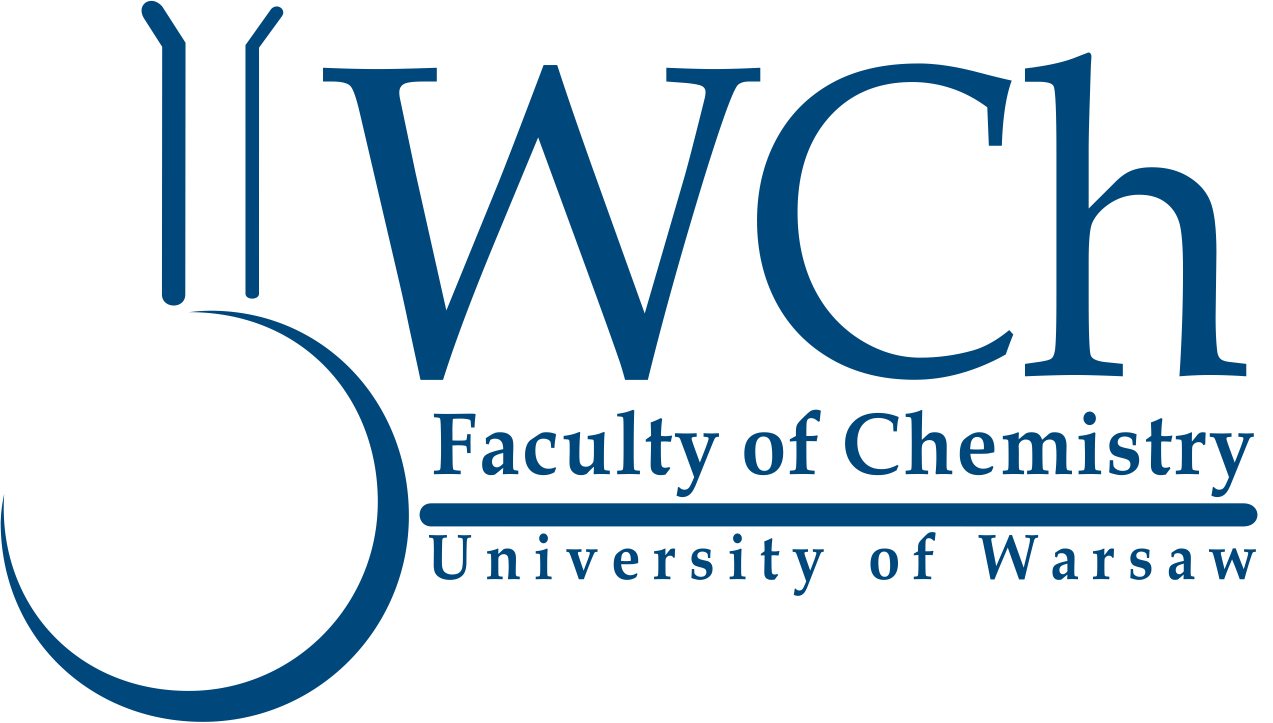Philip Coppens
2013 – 8th WŁODZIMIERZ KOŁOS AWARD
by invitation from the Polish Chemical Society
and the Faculty of Chemistry, University of Warsaw
PROFESSOR PHILIP COPPENS
Distinguished Research Professor of Chemistry,
University at Buffalo/SUNY, USA

LAUDATION
Mr. President, Mr. Dean,
Dear Philip and Marguerite,
Ladies and Gentlemen,
It is my great honor to introduce Prof. Philip Coppens a worldwide known crystallographer who has been awarded the 8th Kołos Medal Award and has joined us today with his wife Marguerite.
Prof. Philip Coppens was born in Amersfoort, Holland and received his B.S. and Ph.D. degrees in physical chemistry from the University of Amsterdam, Holland in 1954 and 1960, respectively. The title of his PhD thesis was: “Structure and Lightsensitivity of Crystals of Some Organic Nitro Compounds”. Then Philip went on to complete postdoctoral work at Brookhaven National Laboratory, followed by professional appointments at the Weizmann Institute and Brookhaven. Philip joined SUNY Buffalo in 1968 where he currently holds the Henry M. Woodburn Chair of Chemistry.
Prof. Coppens’ work combines crystallography, chemical synthesis, theoretical chemistry and spectroscopy, and includes the development of new methods for the study of solids by X-ray diffraction and spectroscopy. Prof. Coppens’ contributions to the field of science are numerous and therefore let me briefly mention only the most important ones.
First of all, Prof. Coppens created a solid base for reliable diffractional studies by introducing several experimental corrections which account for, for example, primary and secondary extinction and absorption for camera and diffractometer data. These papers have more than 1200 citations. A novel photocrystallographic synchrotron Laue technique developed in his group quite recently constitutes a kind of continuation of methodological developments. This technique shortens time of data collection and thus allows for time-resolved studies of light-induced excited states in crystals on a very short (sub-microsecond) time scale. There is also a Polish contribution to this work as dr. Anna Makal, dr. Jarosław Kalinowski from the University of Warsaw, and dr. Elżbieta Trzop from Wrocław Technical University, were involved in this project.
As X-rays are scattered almost entirely by electrons, they can be used to map the electron distribution in solids, thus shedding light on the chemical bonding in molecules. Prof. Philip Coppens is the co-founder of the field of quantitative experimental charge density investigations. The most common approach in this field is called the Hansen-Coppens formalism and his famous 1978 paper in Acta Crystallographica A introducing aspherical atom refinement for small molecules has earned almost 1000 citations since then. This work opened a new era in crystallography by giving a quantitative tool to study details of electron density and allowing to increase at least one order of magnitude precision and accuracy of X-ray structural analysis. In consequence, derivation of reliable electron density, electrostatic potential and other electrostatic properties, such as dipole, quadrupole, or higher moments, was possible. Electrostatic properties are required for the understanding of chemical reactivity, the lattice energy of crystals, the folding of biological macromolecules, and interactions between enzymes and substrates.
I would say that the work of Max von Laue, William Lawrence Bragg and William Henry Bragg allowed for qualitative studies of intermolecular interactions in crystals, whereas Philip’s accomplishments have moved the field towards quantitative characterisation of electron density distribution in crystals far beyond molecular structure, also significantly improving the quality of structural information obtained from X-ray experiments. One of the most important consequences resulting from the above approach is the idea of banks of pseudoatoms which can then be used to reconstruct electron density distribution in macromolecules, and also in small molecules, allowing for a deeper insight into mechanisms of biochemical processes. One of the most popular databanks of pseudatoms UBDB was created in his group. UBDB stands for the University at Buffalo Data Bank. A successful further development of this bank and examples of its application, including estimation of electrostatic energy of interactions between proteins and drug molecules, have been accomplished by dr. Paulina Dominiak from the Department of Chemistry of the University of Warsaw and PhD students collaborating with her.
Advances in the development of more quantitative methods of crystallography allowed for studying subtle electronic effects in the solid state. In consequence, Prof. Coppens is also the founder of the field of photocrystallography i.e. time-resolved studies of light-induced excited states in crystals. Using synchrotron radiation and excitation by laser-light at low temperature, this approach allows determination of the geometry of molecular species that exist for only microseconds or less. Prof. Coppens is also involved in studying chemical reactions in complex solids and examining how molecules change as the reaction proceeds..
His other research topic is using crystallography to analyze photoluminescence in crystals. Prof. Coppens is interested in how crystals emit light: what happens and how the transmission occurs. This fundamental research leads to advances in organic light-emitting diode (OLED) technologies, and enhances understanding of photosynthesis and photovoltaics (the use of the solar energy) processes.
Philip also uses the methods of crystal engineering to synthesize numerous new supramolecular solids. They are used to study the properties of molecules embedded as guest in the cavities of molecular frameworks. As in solution this allows molecular dilution, but with the distinction that a periodic array is maintained. Such embedding influences their properties.
In all above fields and while studying other challenging problems, Prof. Philip Coppens has published more than 430 papers so far and delivered more than 300 lectures and seminars. His publications have been cited ca. 17 000 times and his H index is equal to 63. He is the author of two monographs: „X-ray Charge Densities and Chemical Bonding” published by Oxford University Press, New York, 1997 and “Synchrotron Radiation Crystallography” published by Academic Press, London, 1992 and editor and co-editor of four others.
Prof. Philip Coppens has never avoided any kind of services to scientific community being within the past years among others: the President of the International Union of Crystallography (1993–1996) and earlier the member of the Executive Committee of the International Union of Crystallography (1987–1999), President, American Crystallographic Association (1978), Co-Editor of the Journal of Synchrotron Radiation (2011-present), Acta Crystallographica A focused on the Fundamentals of Crystallography (2002-2011), CrystEngComm (2002-2005), Journal of Crystal and Molecular Structure (1977–1981), Guest Editor for Chemical Reviews devoted to the thematic issue “X-rays in Chemistry” (2000), member of numerous committees including the Advisory Committee, Board of Governors, Steering Committee for the Advanced Photon Source, General Committee of the International Council of Scientific Unions (1996-1999), Chemistry Review Panel of the Linear Coherent Light Source (LCLS – from 2010-present), Committee on International Relations of the American Institute of Physics (1986–1988), Member of the Advisory Committee for the Brookhaven National Laboratory and Chemistry Subcommittee Chairman (1984–1991), the Materials Research Advisory Committee of the National Science Foundation (1980–1982), Commission on Neutron Diffraction, International Union of Crystallography (1975–1978), USA National Committee for Crystallography of the National Academy of Sciences (1972–1975, 1977–1980, 1987–1999), Commission on Charge, Spin and Momentum Distributions of the International Union of Crystallography (1972–1982) and many others university committees and commissions.
Prof. Coppens chaired and co-chaired 15 international conferences and workshops including such prestigious ones as the Gordon, IUCr, American Crystallographic Association, Sagamore and ACS meetings.
Philip has created one of the strongest groups of crystallographers all over the World. Ca. 100 postdoctoral fellows and associates have joined his group over the past years many of whom are now leading scientists in the field of modern crystallography and also including many Polish young scientists. Among those who joined him are among others: dr Jarosław Majewski from the Academy of Sciences in Warsaw (1990), dr. Jacek Zaleski from the University of Opole (1996-1997), dr. Paulina Dominiak from the University of Warsaw (2005-2006), Adam Dominiak from the Warsaw’s School of Information and Technology (2005-2006), dr. Mateusz Pitak from the Jagiellonian University in Cracow (2006 – 2008), dr. Radoslaw Kaminski from University of Warsaw (2009-2010, 2013-present), dr. Elzbieta Trzop from the Technical University in Wrocław (2010-present), dr. Anna Makal from the University of Warsaw (2010-2012), dr. Jaroslaw Andrzej Kalinowski from the University of Warsaw (2010-2012), dr. Katarzyna Jarzembska from the University of Warsaw (2013-present) and Grzegorz Wesela-Bauman from the University of Warsaw (2013).
Prof. Philip Coppens has been awarded numerous awards and prizes including: the Ewald Prize of the International Union of Crystallography (2005), Martin Buerger Award of the American Crystallographic Association (1994) and American Crystallographic Association Fellowship (2011), Nishikawa Prize of the Crystallography Society of Japan (2005), Gregori Aminoff Prize of the Royal Swedish Academy of Sciences (1996), Doctor Honoris Causa of the University of Nancy (1989), Western New York Pioneer of Science Award of the Hauptman-Woodward Medical Research Institute (2008), National Science Foundation Creativity Award (2005-2007), Schoellkopf Award of the American Chemical Society (1996), Harker Award of The Hauptman-Woodward Medical Research Institute (1995), Henry M. Woodburn Chair of Chemistry (1999-present), Honorable Visitor of the National Science Council of the Republic of China (1995), Corresponding Member of the Royal Dutch Academy of Sciences, American Association for the Advancement of Science Fellow (1993), etc.
It appears that there is also an unexpected, quite close a connection between Prof. Coppens and Prof. Kolos’ group. In 2006, Prof. Coppens with coworkers published in Acta Crystallogr. D 62, 639-647 (2006) a joint paper on: “ Interaction energies between glycopeptide antibiotics and substrates in complexes determined by X-ray crystallography: application of a theoretical databank of aspherical atoms and a symmetry-adapted perturbation theory based set of interatomic potentials” co-authored by X. Li, A. V. Volkov, K. Szalewicz and P. Coppens. Prof. Krzysztof Szalewicz is a former member of Prof. Kolos’ group in Warsaw now persuing his career in USA.
Dear Philip, our congratulations and many thanks for your outstanding contribution to science, for all your new challenging scientific ideas making modern crystallography a real frontier of science, and also for so many years of friendly and fruitful contacts between you and and many young as well as mature researches from different polish scientific institutions.
Krzysztof Woźniak
September 17, 2013
